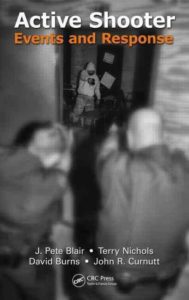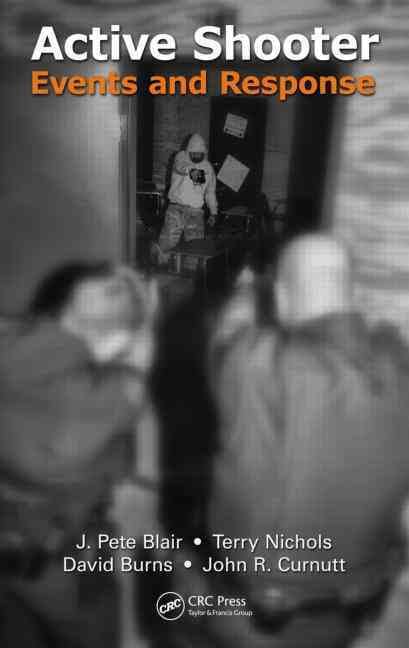 Active Shooter: Events and Response is written by members of the Advanced Law Enforcement Rapid Response Training (ALERRT) Center at Texas State University: J. Pete Blair, Terry Nichols, David Burns, and John R. Curnutt. I am familiar with this group because a few of the law enforcement officers of our training group know these authors, and in the Acknowledgments, Marcus “Sandy” Wall is thanked for helping introduce the training methodology and curriculum that became the ALERRT program. I mention this because Sandy Wall was one of the instructors who taught the Safariland Trainer Course “Emergency Response to an Armed Intruder” that I attended.
Active Shooter: Events and Response is written by members of the Advanced Law Enforcement Rapid Response Training (ALERRT) Center at Texas State University: J. Pete Blair, Terry Nichols, David Burns, and John R. Curnutt. I am familiar with this group because a few of the law enforcement officers of our training group know these authors, and in the Acknowledgments, Marcus “Sandy” Wall is thanked for helping introduce the training methodology and curriculum that became the ALERRT program. I mention this because Sandy Wall was one of the instructors who taught the Safariland Trainer Course “Emergency Response to an Armed Intruder” that I attended.
Since I’ve been studying active shooter events, and teaching courses on responses to active shooters, I started reading this book with more knowledge than many readers. I found the book to be well organized, on-point, and a great resource for my own writing and teaching on the subject. I will point out that the courses I teach are for civilians, many teachers and school employees, and this book has a large portion on law enforcement response and tactics. However, there are chapters on civilian responses to active shooters that mirrors the classes we teach.
Here is what this book covers chapter by chapter:
- Historical Perspective of Active Shooter Events. This is a good introduction to the topic, and explains why law enforcement have new paradigms in crisis decision making and different tactics for these increasing events.
- Increased Complexity of Events. Good discussion on active shooter and terrorist active shooter threats that includes a look at events in Beslan, Russia; Mumbai, India; Norway; and Mexico.
- Active Shooter Events in the United States from 2000 to 2010. Good break down and analysis of Active Shooter Events in this ten year period. The most alarming statistic is the upward trend of these horrific events.
- Preparing for the Event. This chapter explains the main goals of law enforcement officers: Stop the killing, and then stop the dying. This is important to know. Law enforcement cannot stop to help with the injured until the threat has been neutralized. This chapter also discusses the concept of principle-based training and the mindset of first responders. It concludes with a little about equipment.
- En Route and Actions Outside the Building. Priorities of work, teams, cover, approaching, and breaching are some of the topics in this chapter.
- Entry and Confronting the Threat. This chapter focuses on principles of team movement, communication, tactics, room entry, IEDs (Improvised Explosive Devices)and threshold evaluation.
- Postengagement Priorities of Work. Security, Immediate Action Plan, Medical, and Tactical Emergency Casualty Care are a few of the topics covered in this chapter.
- Civilian Response to Active Shooter Events. This chapter was most relevant to the teaching I do with school and business employees. The chapter addresses concepts of disaster response such as Denial, Deliberation, Decisive Moment, and Stress. They then explain their ADD formula: Avoid, Deny, Defend. This is the same as the Federal Run, Hide, Fight, Safariland’s Run, Lock, Fight, and my Escape, Deny, Attack Back. These are just different names for the same response concepts. The book also includes a little on what to expect when the police arrive and a little on developing a policy for response to active shooter events.
The book then concludes with an Appendix that contains brief summaries of all of the Active Shooter Events from 2000 to 2010. These are the events that are included in the chapter with the break down and analysis.
I found Active Shooter: Events and Response to be a very good book on the topic. It is a very good reference for my writing and teaching, and I feel it would be a good read for all law enforcement as well as civilians wanting to know more about what both law enforcement is doing in response to these events and what they can do if ever faced with such an unthinkable situation.
Knowledge is power, and this book provides knowledge on the history of active shooter events and what can be done to address this increasing threat. I wish a book like this wasn’t necessary, but in the times we live in, I’m glad this book is available to provide the information to those of us in the good fight. Train and prepare before one of these situations occurs in your hometown, and may you never need your training. Stay safe.
Active Shooter: Events and Response at amazon:

